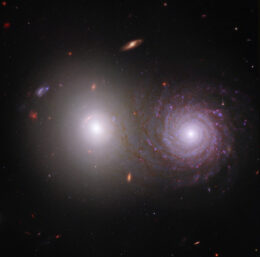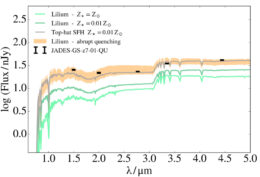Earlier this year, researchers using JWST discovered a galaxy that stopped forming stars just 700 million years after the Big Bang. Cosmological simulations provide a way to study sudden star-formation shutdowns in early galaxies like this one.

This image of the VV 191 galaxy pair combines data from the Hubble Space Telescope and JWST. Elliptical galaxies, like the left-hand galaxy in this image, usually have little or no star formation, while spiral galaxies, like the one on the right, are alight with new stars. [NASA, ESA, CSA, Rogier Windhorst (ASU), William Keel (University of Alabama), Stuart Wyithe (University of Melbourne), JWST PEARLS Team, Alyssa Pagan (STScI); CC BY 4.0]
Young Galaxies in the Early Universe
In the first few million years after the Big Bang, stars came to light and galaxies assembled, steadily brightening the infant universe. But star formation cannot continue forever, as evidenced by the many galaxies in the universe today whose star formation has drawn to a close.
For galaxies to exhaust their star-forming gas after 13 billion years may not be surprising, but JWST has revealed a galaxy that stopped its star formation far sooner, less than one billion years after the Big Bang. The galaxy, JADES-GS-z7-01-QU, provides an opportunity to study processes that halt star formation — either temporarily or permanently — in the early universe.
Stop-and-Go Star Formation
To understand why a galaxy might stop forming stars so early in the universe’s history, a team led by Viola Gelli (University of Florence and Italian National Institute for Astrophysics/Arcetri Observatory) turned to cosmological simulations. Using the Sᴇʀʀᴀ simulations, Gelli and collaborators gathered a sample of 130 galaxies with redshifts and masses similar to JADES-GS-z7-01-QU. The team found that about 30% of these galaxies had no star formation, and less massive galaxies in the sample were less likely to be star forming than more massive galaxies.

Snapshots of the Sᴇʀʀᴀ simulations at a redshift of 6 showing the stars (left) and gas (right) of typical active and quiescent galaxies. Click to enlarge. [Gelli et al. 2023]
Abrupt Transition Needed

Spectral energy distributions of simulated galaxies compared to JADES-GS-z7-01-QU. The simulated galaxy singled out for further study is named Lilium. Click to enlarge. [Adapted from Gelli et al. 2023]
What could be the cause of such a sharp shutoff in star formation? Although heating of star-forming gas by supernovae appears to be ubiquitous in low-mass galaxies in the early universe, the lag between when massive stars form and when they explode as supernovae means a shutdown due to supernovae can’t happen less than 30 million years after star formation starts. In the case of JADES-GS-z7-01-QU, something else must be at play — perhaps the powerful winds of young stars or an accreting supermassive black hole at the galaxy’s center could be responsible for rapidly shutting off star formation in JADES-GS-z7-01-QU. As JWST observes more quiescent galaxies in the early universe, we’ll be able to investigate the causes of stalled star formation further.
Citation
“Quiescent Low-Mass Galaxies Observed by JWST in the Epoch of Reionization,” Viola Gelli et al 2023 ApJL 954 L11. doi:10.3847/2041-8213/acee80
